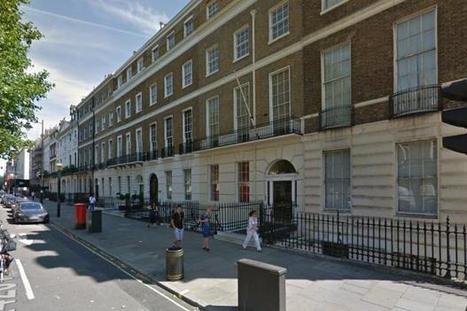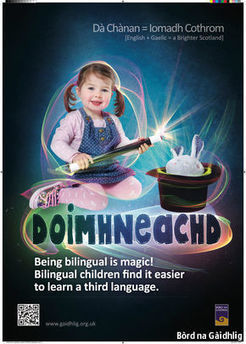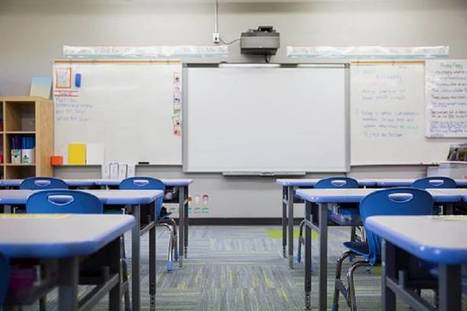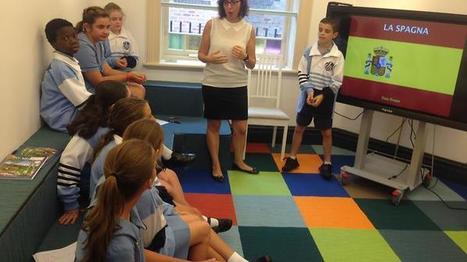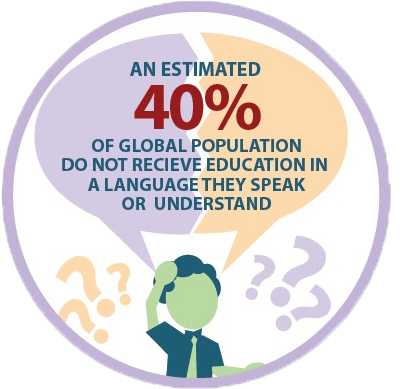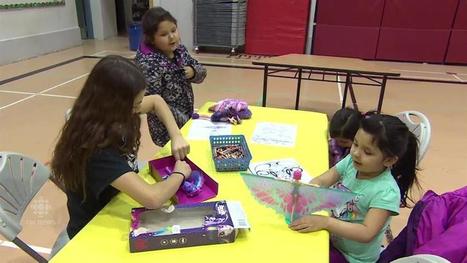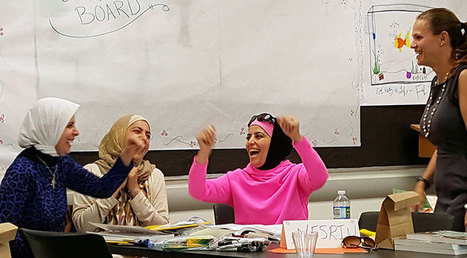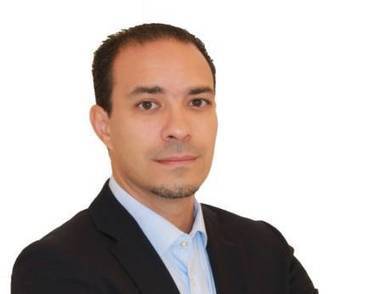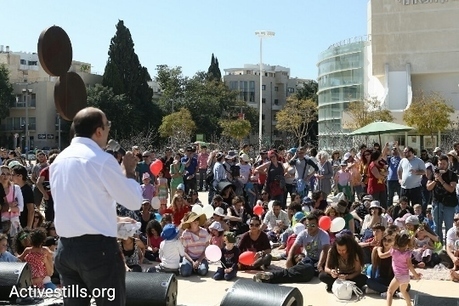 Your new post is loading...
Published by the Evening Standard, May 3, 2016 London's first “all-through” bilingual school, where pupils are taught in a different language depending on the subject, has been officially opened.
Children can start in the nursery of L’Ecole Internationale Franco-Anglaise (EIFA) at the age of 18 months and stay at the school till they are 18 years old.
Published by the Economist, April 23, 2016 Gaelic is making a comeback in Scotland!
Published by the Buenos Aires Herald, April 13, 2016 The continued advantages of “bilingual” English and Spanish language skills were on display at the British Embassy in Buenos Aires yesterday, which hosted a special event with the Cambridge English Language Assessment body, highlighting the ongoing potential for English language education in Argentina. British Diplomats at the Embassy building praised the organization’s “excellence” in language assessment and advocated that the event’s theme — “On the road to Bilingualism” — is crucial in the current global environment. “We all know that we live in a world that is every day more and more globalized and interconnected, and so it’s increasingly important to know more about our languages, whether that be in the realm of professional, educational or personal life,” a British embassy representative told a packed audience at the Embassy in Recoleta neighbourhood yesterday.
Published by Global News, March 8, 2016 The Winnipeg School Division (WSD) Board of Trustees has approved a plan to introduce three new bilingual language programs to its division – Spanish, Cree and Ojibwe.
The Board required a certain amount of students to register for the programs in order to move ahead with the plan.
“We’re very pleased to be offering these bilingual language programs in our division,” said Winnipeg School Division Chair Mark Wasyliw.
“I commend the community members who have worked so hard to get these heritage languages in place.”
The new bilingual language program start at Kindergarten with each year adding the next grade.
Published by SBS, April 7, 2016 This story is part of a five-part series about bilingualism and language education in Australia It‘s Tuesday morning at the Italian Bilingual School in the Sydney suburb of Meadowbank and 11-year-old Sam Evans is giving a presentation about Spain to a small class of Year 6 students.
Published by the Irish Times, March 7, 2016 Ireland’s efforts to build a globalised economy are unsustainable in the long run, given its failed foreign language education policy, particularly in German, according to Irish business leaders and academics. Heads of multinational companies operating in Ireland say they cannot understand why they are forced to go outside the state to recruit the thousands of multilingual staff they need. Employers organisation Ibec, meanwhile, said Ireland’s foreign language failure was “the most intractable of policy challenges” that was hobbling growth potential of both home-grown companies and of the Irish economy.

|
Scooped by
Dual Language Education of New Mexico
February 21, 2016 4:06 PM
|
Published by the Huffington Post, U.K., February 19, 2016
How a country chooses the language for its education system is not an easy process. The decision is usually influenced by multiple factors: colonial history, origins of immigrants, legal recognition of minority languages, cultural diversity, political interests - to mention but a few. In some cases, instruction is provided in more than one language; in others the medium of instruction may vary between primary and secondary education.
Underneath this tangled and evolving web of policies and priorities, however, lies an undeniable truth: teaching and assessing children in a language they understand will result in better learning. This is something that has been recognised now for decades. It is written into the 1989 ILO Convention and Convention on the Rights of the Child and the 2001 Universal Declaration on Cultural Diversity. Our new paper out today, 'If you don't understand, how can you learn?' confirms this basic principle, and yet reports that, despite the overwhelming evidence supporting this claim, 40% are still not able to access education in a language they understand. It is clear that the complex nature of factors affecting language-education policy still take precedent over the accumulation of evidence.
Published by CBC News Manitoba, January 26, 2016
The Winnipeg School Division says it has already dozens of students registered for a new bilingual program that will teach the Cree and Ojibwa languages starting this fall.

|
Scooped by
Dual Language Education of New Mexico
October 30, 2015 11:38 PM
|
Investing in education leads to paving the right path towards Latin America's transformation, Peru's President Ollanta Humala affirmed.
Published by the Shanghai Daily, October 7, 2015
More students in Xinjiang Uygur Autonomous Region are being educated in both their native language and Mandarin than in 2010, the latest statistics from the regional education department showed.
By the end of 2014, the number of primary and secondary students receiving bilingual education in Xinjiang had increased from 999,000 to two million, with 480,000 in kindergartens. A total of 69 percent of ethnic minority children received bilingual education in elementary and secondary schools, up from 34 percent in 2010.
Published by the Euro Weekly News, August 24, 2015
The Murcia Region is starting the new school year with 31 schools joining the bilingual education programme, through the initiative promoted by the regional government.
The programme includes alternating classes in primary schools being taught in Spanish and English and the number of centres following the initiative is growing, with 254 schools offering bilingual education to over 35,000 students. The regional government hopes to have the bilingual model in place in all schools by 2020.
ublished by CNTV, August 18, 2014
China's latest reform measures on education are on ethnic minorities. China's Cabinet, the State Council has released a document that says " Education of ethnic minorities lags far behind the country's average, it should be given a more prominent position". It promises greater financial support and "scientific and steady" promotion of bilingual teaching, and education in ethnic regions should achieve the national standard by the end of 2020. CCTV's Jin Yingqiao joins me in the studio for more.
Published by The Conversation August 10, 2015
For language learners, the two-way immersion program has shown high success rates. What makes the program so effective?
|
Published by the CSUF News Service, May 9, 2016 Education faculty members hold a "train the trainer" workshop for a group of volunteers who plan to travel to the Middle East this summer to help Syrian refugee children.
Published by Murcia Today, April 20, 2016 Murcia Schools Introduce More Bilingual Education Programs
Published by Gulfnews, April 13, 2016 Being able to speak two languages has become a minimal expectation for parents in the UAE.
The immediate target is to teach children at least Arabic and English, and seek out the best ways to do this.
By the time children are eight months old, those raised in bilingual homes seem to have skills not possessed by those raised in monolingual homes. Research demonstrates that learning a second language can significantly enhance literacy skills development.
Published by SBS, April 7, 2017 This story is part of a five-part series about bilingualism and language education in Australia The chair of Indigenous linguistics at ANU University has called for a national strategy to improve Indigenous language education in schools as poor rates of attendance and performance continue to plague communities.
Published by +972 Magazine, March 11, 2016 Hundreds of Jewish and Arab parents and children from Jaffa protested in central Tel Aviv Friday morning to demand that the city provide them with an option to study in an integrated, bilingual school that treats both languages, cultures and the three monotheistic religions equally.
The parents claim that the arrangement being offered to them by the city is not actually equal and does not satisfy their needs.
There are only seven integrated, bilingual schools in all of Israel.
Published by Telesur, March 9, 2016 Ecuadorean President Rafael Correa participated in an inaugural event marking the launch of the country’s eighth bilingual school, forming part of a national strategy to strengthen Indigenous identity.“Our challenge is to overcome poverty without losing our identity, in order to maintain such identity, we must strengthen bilingual education,” Correa stated during his inaugural speech Tuesday at the Wankurishpa Yachana Pampa Mushuk Ayllu school in Orellana.
Published by Andina, February 5, 2016
The National Intercultural Bilingual Education Plan ensures quality education in indigenous languages. The Ministry of Education-Minedu expects that 9 out 10 indigenous children will complete primary education in due time by the time the country celebrates 200 years of independence, in 2021.

|
Scooped by
Dual Language Education of New Mexico
December 17, 2015 9:45 AM
|
Published by Language Magazine, December, 2015
As demands grow for biliteracy in California, Cynthia García Dehbozorgi and Nehemias Giménez García compare the state’s initiatives to those of Spain.
Published by the Times of Israel, October 27, 2015
It is unfortunate that the kind of Arabic taught today by the Education Ministry is literary Arabic with absolutely no emphasis on spoken Arabic, which would actually help people communicate with each other.
The innovation of the Yad beYad schools is that they offer total bilingual education, with each class taught by two teachers, one Jewish and one Arab, each teaching in their native language (including both literary and spoke Arabic).
Kids at the school are taught from age three that speaking Arabic or Hebrew is normal, that being friends with Jews or Palestinians is normal; that we may live in different neighborhoods, speak different languages and celebrate different holidays, but that at the end of the day we are all really the same — just people.
It’s not easy to put this out publicly when there is so much fear and animosity in the air, but the fear and animosity will never dissipate if we don’t encounter the humanity of the other and create a sense of trust, as Sarah Tuttle-Singer suggests.
We can choose another way. We can choose bi-lingual and multicultural education for our children as a path towards mutual trust and coexistence.

|
Scooped by
Dual Language Education of New Mexico
September 14, 2015 9:08 AM
|
Published by Mexico News Daily, September 12, 2015
Mexico will be bilingual within 10 to 20 years, the Secretary of Education forecast yesterday, as the government is preparing a national English program.
Published by the Inquirer.net August 23, 2015
A nation of ‘fifth graders,’” the late Dr. Josefina R. Cortes, former dean of University of the East College of Education, said of our country that has long suffered from poor learning
The question of what language(s) to teach Indigenous students, what languages to teach them in, and how to go about it has been generating a little political heat (but not quite so much light) of late…
|



 Your new post is loading...
Your new post is loading...

